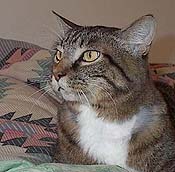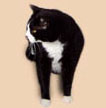Vol. 2, No. 8
Table of Contents
Feline Nutrition: Just Some Stuff
Assist Feeding: Bert – Jaundice is Fading!
Kitty Potpourri: Room Service Please!
Caring for Cats: Proactive Plan: Step-4
Feline Nutrition
Just Some Stuff.
by Garry White
Busy, busy week, folks. And on top of that, the research I had planned for this week’s article is taking a bit longer than planned; one would think these universities could put their own schedules aside to accommodate my requests for information, wouldn’t one? However, this gives me a chance to cover a few other minor issues.
Clean cat food bowls/drinking bowls:
(This one’ll bowl you over): Typically, we consider dry food to be non-dangerous, as compared to the spoilage rate of canned food, and we’re sort of correct in that assumption. But not entirely; dry food spoils too, just not as quickly. Canned foods and cooked or fresh foods, though, are our biggest concern. Most foods contain at least some bacteria, and meats contain even more. As we know, bacteria needs warmth and moisture to proliferate, but what we might not know is that once conditions have been established for growth, some bacteria that turn food into poison (campylobacter, salmonella, listeria, E.coli O157, clostridium perfringens) to name a few, subscribe to the divide-and-conquer philosophy: One becomes two, two becomes four. A single bacterium can become several million in 8 hours, and thousands of millions just a few hours later! Rabbits don’t hold a candle to these little beasties, huh! Point is to think of it this way: An hour or so means bad things are underway. Another hour or so means the food is humming with potentially poisonous bacteria; maybe the cat’s digestive system can deal with it, and maybe not. Another few hours could mean disaster. So we need to keep those cat food bowls and plates clean! If it’s canned food, a few hours at most. If it’s dry, at least daily. Plus, remember that cats eat what smells good, and a cat food bowl that doesn’t smell good will repel them from eating, even if the food you just dumped in there is fresh!
Sneezers:
Wouldn’t it be nice if we could have sneeze-hoods for the food bowls, just like they do at the Ponderosa Steak House salad bar? But we can’t, so we have to deal with our furry sneezers a bit more individually. Starting, of course, with the knowledge that feline upper-respiratory infection is one of the most contagious bacteria on the planet. Ask our editor, Kathy, who went through it with her dear Nicholas. Poor Kathy was stuffing towels under the doors, taking showers and changing clothes to go to the kitchen for a peanut-butter sandwich, and in the end the bug still won. All the cats in her house got it! Now imagine an infected cat sneezing and spreading those highly contagious germs into a warm, moist, community cat food bowl or water dish. YIKES! Look, we all see it as “mean” to isolate a kitty, and especially a sick one, but in truth it’s the kindest thing we could possibly do. First of all to the other cats in residence, but also to the sick one. Cats, unlike humans, can catch the same virus more than once, so a nasty bug can bounce back and forth many times, if we don’t contain the situation.
So be careful and attentive to what’s going on, and always be conscious of what’s growing in that cat food or water bowl.
Assist Feeding
Bert – Jaundice is Fading!
by Kathy Fatheree
Last week…  we learned how Bert’s parent’s check for a full tummy via Bert’s PEG tube. This is a necessary thing to check for since we wouldn’t want to feed him when his belly is still full. Some kitties digest their food slower than others… especially if they are sick and have a low activity level.
we learned how Bert’s parent’s check for a full tummy via Bert’s PEG tube. This is a necessary thing to check for since we wouldn’t want to feed him when his belly is still full. Some kitties digest their food slower than others… especially if they are sick and have a low activity level.
Here’s This Week’s Update:
Another great day to report! Bert is still doing wonderful and seems to be getting better by the hour. Mitch and I are having a bit of trouble with the feedings though, more specifically. the rate at which we should feed. We found a pace that we thought Bert was comfortable with, but between the increase in amount (he’s on 53cc’s now, up from 20 when he first came home from the hospital) and we are apparently going a little too quickly because he threw up again. We’ve decided that it doesn’t matter if it takes an hour, we will not do more than 2cc’s a minute. He seems to do wonderful with that speed and doesn’t drool or smack his lips at all. When he starts with the heavy salivation we know we’ve gone too fast and as soon as he starts smacking his mouth we know he’s going to throw up. It’s not funny at all but he threw up all over our bed; covers, sheets and pillows. We capped his tube and got out fresh bedding and sat him in the middle of the clean comforter while we stripped the bed. What was so funny is he sat there the entire time and watched us! As soon as we were done and tossed the last pillow on the bed, up he came! It made me laugh, he actually sat and waited for us to put clean sheets and covers on. 🙁 I feel just terrible about his throwing up, but also I know that it is going to take us a bit of trial and error. I just got done with his middle of the night feeding and he’s sound asleep next to Mitch. Apparently things went so smoothly that neither of them felt the need to wake up!! Over all I would say things are going very smoothly.
Jaundice is a sign of liver problems
I can’t believe that I didn’t mention the jaundice! The jaundice is the reason that Dr. H admitted him into the intensive care the very first time he stayed! We took him in for his blood work and Dr. H noticed that the inside of his ears were off color (not yet bright yellow, barely noticeable really). He said that Bert would have to stay overnight so they could start the fluid therapy on him. His jaundice progressively got worse. The day of Bert’s PEG tub surgery, his ears looked like someone had colored the inside with a marker. That’s why I was so pleased to notice now that they are returning to a pink color. We can still see a yellow tinge but the bright yellow is completely gone!
NOTE: Here is how MedLine Plus explains Jaundice:
“Jaundice is a yellow color in the skin, the mucous membranes, or the eyes. The yellow pigment is from bilirubin, a byproduct of old red blood cells. If you’ve ever had a bruise, you may have noticed that the skin went through a series of color changes as it healed. When you saw yellow in the bruise, you were seeing bilirubin. Normally, about 1% of our red blood cells retire every day, to be replaced by fresh red blood cells. The old ones are processed in the liver and disposed of. Much of the resulting bilirubin leaves the body in the stool. If there are too many red blood cells retiring for the liver to handle, yellow pigment builds up in the body. When there is enough to be visible, jaundice results. Jaundice can be caused by too many red blood cells retiring, by the liver being overloaded or damaged, or by the inability to move processed bilirubin from the liver through the biliary tract to the gut.”
The Great Cat Clinic that is Caring for Bert
The name of the cat clinic is Animal Specialty Hospital, 5775 Schenck Avenue, Rockledge FL 32955. (321) 752-7600. The name of the tech that we adore is Lalane. The hospital is by referral only and after they close at 6 they turn into one of the area’s emergency clinics. It’s a beautiful property with spacious exam rooms. I can say without a doubt that they saved Bert’s life. Everyone there is absolutely wonderful!
Kitty Potpourri
Room Service Please!
by Dan Malenski
This week, from our “Remarkable Cat Tales” department, we will tell you about what we think is the ultimate in room service for those seeking hotel accommodations. I have my research assistant, Melissa, to thank for uncovering this interesting story about a hotel in the State of Minnesota. The information for the story was gleaned from internet sources and the website of this remarkable hotel, the Anderson House Hotel.
On a cold winter night, where can a traveler rest his cold and weary body and expect a warmed brick to warm his or her feet and a friendly, cuddly kitty to warm the heart, and all at a very reasonable rate? At the historic Anderson House in Wabasha, MN,  the oldest operating hotel in the state-that’s where! As soon as one checks in, it is apparent that this is no ordinary hotel with an ever-filled cookie jar at the front desk and a menu that features Pennsylvania Dutch cooking dating back to its opening in the year 1856. Shoes left outside the door are shined by the human staff, just as was done in the days past. The hotel has twenty-two rooms, each with a private bath or shower and each with its own unique furnishings. Rates start from $69.00 a night, which is competitive with those facilities that are not feline friendly.
the oldest operating hotel in the state-that’s where! As soon as one checks in, it is apparent that this is no ordinary hotel with an ever-filled cookie jar at the front desk and a menu that features Pennsylvania Dutch cooking dating back to its opening in the year 1856. Shoes left outside the door are shined by the human staff, just as was done in the days past. The hotel has twenty-two rooms, each with a private bath or shower and each with its own unique furnishings. Rates start from $69.00 a night, which is competitive with those facilities that are not feline friendly.
 The service of providing a cat to a guest who requests one was not always available but was started a little over twenty years ago when a guest nonchalantly mentioned to proprietor John Hall at the time that he had been on the road so long, even a cat would be a welcome companion. Without another thought, Hall’s mother delivered the family cat to the guest’s room, who remarked the following morning that he had spent his most memorable night in 26 years of traveling. This remark was the trigger that initiated the service of providing a cat to a guest who requests one, and this service still exists to date.
The service of providing a cat to a guest who requests one was not always available but was started a little over twenty years ago when a guest nonchalantly mentioned to proprietor John Hall at the time that he had been on the road so long, even a cat would be a welcome companion. Without another thought, Hall’s mother delivered the family cat to the guest’s room, who remarked the following morning that he had spent his most memorable night in 26 years of traveling. This remark was the trigger that initiated the service of providing a cat to a guest who requests one, and this service still exists to date.
For those who request the companionship of a feline, a hotel employee will deliver the cat (or cats) to a room with sleepover essentials that consist of food and a litter box. According to the manager, approximately 25% of his guests request a cat when they phone in their reservations and on any given night, more than half his guests wind up sharing their rooms with a feline. Now, where can you find better room service than that?
For those who choose to visit the hotels website, you may click on the following:
The Historic Anderson House Hotel
You will note that the option of choosing to have a feline roommate is not actively advertised on their website, probably to not offend the d*g people, but is only suggested in their logo and by a tuxedo cat pictured on their rates page. Therefore, if you ever need a hotel in the area, be sure to choose the Anderson House, and be sure to utilize this unique service. If you request the companionship of more than one feline, you will likely have your request fulfilled, as the feline staff typically numbers in the area of fifteen. The hotel staff pulls out all the stops to insure that there will never be a weary traveler who will not be able to share a room with a cat.
pictured on their rates page. Therefore, if you ever need a hotel in the area, be sure to choose the Anderson House, and be sure to utilize this unique service. If you request the companionship of more than one feline, you will likely have your request fulfilled, as the feline staff typically numbers in the area of fifteen. The hotel staff pulls out all the stops to insure that there will never be a weary traveler who will not be able to share a room with a cat.
Caring for Cats
Proactive Plan: Step-4
by Garry White
Dealing with veterinarians
I take proactive care seriously, as I’m sure you do, and we try to leave no stone unturned. Well, this particular stone isn’t a rock… it’s a boulder! And for obvious reason: The veterinarian is a crucial link in the chain that leads us to long-term wellness for our furry pals, so it’s important that we find –and keep— a good one. But never lose sight of the fact that you and your cat are the most important link of all.
How to find a good veterinarian:
Better said would be how not to choose a good veterinarian: He’s close by, he’s cheap, and the office people are friendly; the missing ingredient here is ‘conscionable care.’ We could go on forever with discussion about things to look for and things to avoid, but I’ll summarize how I do it. Long ago, I gave up the philosophy that cost equals quality. That’s true up to a point, but not exclusively. Depending on the locale, customer-traffic, and the veterinarian’s operating overhead, office visits can range from $25 for a country vet, to $150 for a swanky, mid-city operation. So disassociate those two from the thinking process. My own first step is to avoid the obvious phonies, and the front-desk folks generally give that away. They’re either serious about the cat’s problem and getting it resolved quickly, or they’re serious about flattering you as to how beautiful Fluffy is. We have to remember who trained those office folks…the vet! ‘Nuff sed about that, eh. I also try to speak with a new veterinarian beforehand, rather than just allow them to assume that I am a new customer because I’m standing in the lobby; I want them to appreciate (and earn) my business, and if they’re too busy to spend a few minutes with a potential new customer, then they’re likely too busy to give my cat the care I’m going to demand.
How to keep a good veterinarian:
Again, we could elaborate this one to death too, but basically I just use a little common sense in remembering that vets are human beings with feelings, not fix-it machines. They’ve spent many, many years learning their trade, and I feel that “the-cat-didn’t-die”, and financial payment, are inadequate as rewards for what they’ve done. So I do the silly stuff, and it seems to be appreciated: Box of donuts every so often, send a picture of the patient every now and then, sometimes a phone call just to say, “Hey, Doc; just wanted to let you know that what you did last time is working like a dream.thanks a million!” Another thing vets like is for you and I to show that we’re sorta in-the-know about some of the basics; it takes a lot of the elementary burden off them.it’s time-saving for them if they don’t have to explain the difference stools we sit on and stools we don’t.
So we first have to find a good vet, and then we have to work at keeping him/her in the family. The methods we might use to do all of that are as individual and varied as fingerprints, but all the hoop-de-do comes down to common sense in the end.
Disclaimer: Kathy Fatheree is not at all a medical expert. Contents of this web site are a collection of Kathy’s assist feeding experiences as well as the experiences of other cat owners who have assist fed their cats. While every effort has been made to ensure the accuracy of the information, Kathy Fatheree or anyone associated with this web site cannot be held responsible for anything that may happen as a result of using the information on this site.
